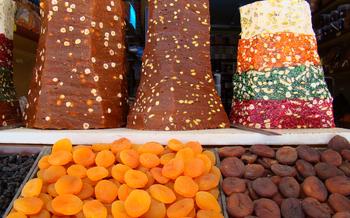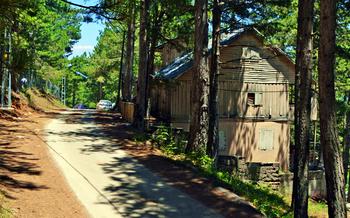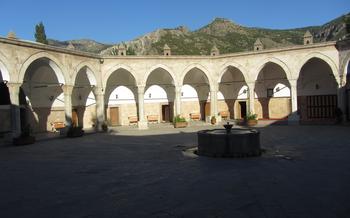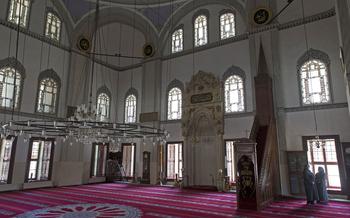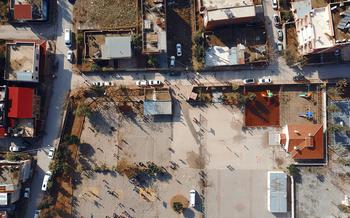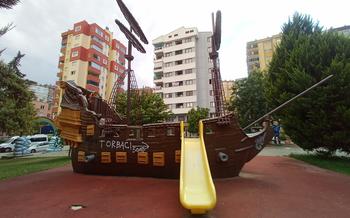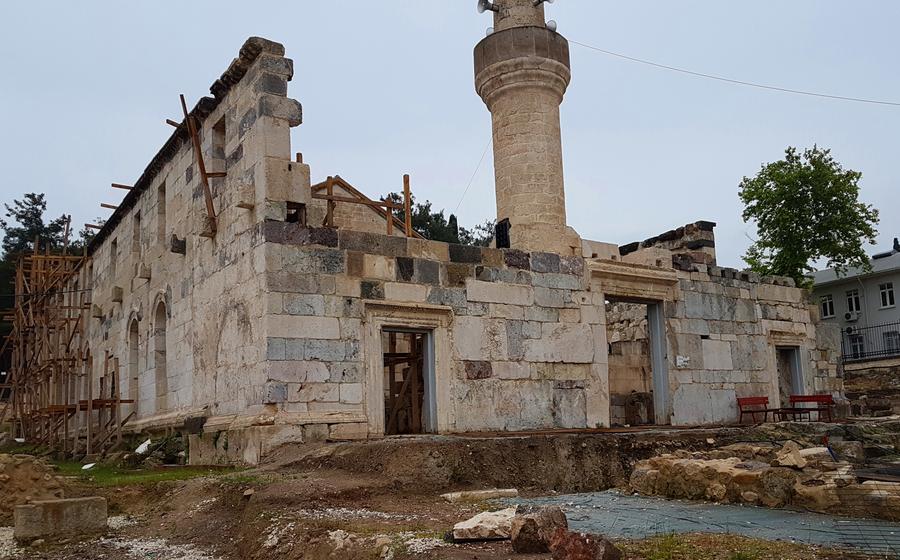
Ala Mosque
- Ala Mosque: A Historical Masterpiece
- Location and Accessibility
- Visiting Hours and Admission
- Exploring the Mosque's Interior
- Ala Mosque's Unique Features
- The Mosque's Role in the Community
- Ala Mosque's Connection to Local Culture
- Nearby Attractions
- Etiquette and Respect
- Historical Context of Osmaniye
- Ala Mosque's Place in Islamic Architecture
- Preservation and Restoration Efforts
- Local Cuisine and Delicacies
- Photography Tips
- Insider Tip: Unveiling the Hidden Courtyard
Ala Mosque: A Historical Masterpiece
History: The Ala Mosque, a testament to the rich history of Osmaniye, dates back to the 16th century. Built during the reign of the Ottoman Sultan Suleiman the Magnificent, the mosque stands as a symbol of the empire's architectural achievements. Its construction is attributed to Alaeddin Bey, the governor of Osmaniye at the time, who played a pivotal role in the city's development. The Ala Mosque has since become an integral part of Osmaniye's cultural and religious landscape, attracting visitors from far and wide.
Architecture: The Ala Mosque showcases stunning Ottoman architecture, a blend of Islamic and Byzantine influences. The exterior façade is adorned with intricate tilework, geometric patterns, and elegant calligraphy, creating a captivating visual display. The interior of the mosque is equally impressive, featuring a spacious prayer hall with a high dome, supported by graceful columns. The mihrab (prayer niche) and minbar (pulpit) are adorned with exquisite carvings and calligraphy, adding to the mosque's grandeur.
Cultural Significance: The Ala Mosque holds immense cultural significance as a symbol of Islamic faith and heritage in Osmaniye. It serves as a place of worship, where Muslims gather for daily prayers and congregational gatherings. The mosque also plays a crucial role in promoting Islamic education and knowledge, with madrasahs (Islamic schools) often attached to its premises. The Ala Mosque stands as a testament to the deep-rooted Islamic traditions and values that have shaped the cultural fabric of Osmaniye.
Personal Experience: Visiting the Ala Mosque was a transformative experience that left an indelible mark on me. As I stepped inside the mosque, I was awestruck by its sheer beauty and grandeur. The intricate tilework, the soaring dome, and the harmonious blend of architectural elements created an atmosphere of tranquility and reverence. The devoutness of the worshippers and the melodious call to prayer transported me to a realm of spirituality and connection. The Ala Mosque not only showcases architectural brilliance but also embodies the essence of Islamic faith and community.
Location and Accessibility
The Ala Mosque is conveniently located in the heart of Osmaniye city center, making it easily accessible for visitors. Its exact address is Cumhuriyet Mahallesi, Atatürk Bulvarı, No: 10To reach the mosque, visitors can take advantage of the city's public transportation system, which offers convenient bus routes that stop nearby. For those traveling by car, limited parking is available in the vicinity of the mosque. Additionally, the mosque is fully accessible for disabled visitors, with ramps and designated spaces ensuring a comfortable and inclusive experience for all.
Visiting Hours and Admission
The Ala Mosque welcomes visitors with open arms during specific hours of the day. To ensure a peaceful and respectful environment, the mosque is usually open for visitation outside of prayer times. Visitors are advised to plan their visit accordingly to avoid any inconvenience. There are no admission fees or charges required to enter the mosque, allowing everyone to experience its beauty and spiritual significance without financial barriers. Guided tours are available for those seeking a deeper understanding of the mosque's history, architecture, and cultural importance. These tours are often led by knowledgeable guides who can provide insightful commentary and answer any questions visitors may have. A nominal fee may be charged for guided tours, but it is a small price to pay for the wealth of knowledge and insights gained.
When visiting the mosque, it is essential to dress modestly and respectfully, adhering to local customs and Islamic traditions. Men and women should ensure their clothing covers their knees and shoulders, and women may be required to cover their hair. This dress code is not only a sign of respect but also helps visitors blend in with the local community.
Exploring the Mosque's Interior
As you step inside the Ala Mosque, you'll be awestruck by the sheer grandeur of the main prayer hall. Its vast space can accommodate thousands of worshippers, creating a sense of unity and devotion. The intricate tilework that adorns the walls and ceiling is a testament to the skill and artistry of Ottoman craftsmen.
The mihrab, the prayer niche indicating the direction of Mecca, is a focal point of the mosque. Its intricate carvings and colorful tiles create a mesmerizing effect, drawing the eyes of worshippers towards the sacred space. The minbar, the pulpit from which the imam delivers sermons, is another notable feature, showcasing fine craftsmanship and adding to the mosque's overall grandeur.
As you wander through the mosque, take a moment to admire the exquisite calligraphy that adorns the walls and pillars. Verses from the Quran and other religious texts are meticulously inscribed in elegant Arabic script, adding a layer of spiritual significance to the space.
Exploring the Ala Mosque's interior is a journey of discovery, where every corner reveals a new treasure. The atmosphere is one of serenity and devotion, inviting you to reflect on your own spirituality and connect with the divine.
Ala Mosque's Unique Features
The Ala Mosque stands out with several unique architectural features that set it apart from other mosques in the region. One striking aspect is its distinctive minaret, which boasts intricate tilework and a unique design that reflects the mosque's Ottoman heritage. The mosque's interior is adorned with stunning calligraphy and decorative elements, including vibrant floral motifs and verses from the Quran. These intricate details showcase the skill and artistry of the craftsmen who worked on the mosque's construction.
Furthermore, the Ala Mosque houses several notable historical artifacts and relics that add to its significance. Among these treasures is an ancient manuscript of the Quran, which is believed to date back to the early days of Islam. Visitors can also admire a collection of antique carpets and lamps that have been carefully preserved within the mosque.
Local legends and stories surrounding the Ala Mosque add to its mystique and charm. One popular tale tells of a pious man who was guided to the mosque by a mysterious light. Another legend speaks of a hidden treasure buried beneath the mosque's foundations, waiting to be discovered by a worthy individual. These stories have been passed down through generations and contribute to the mosque's aura of spirituality and wonder.
Personal Anecdote
During my visit to the Ala Mosque, I was particularly captivated by a local story about a young woman who had experienced a profound spiritual awakening within the mosque's walls. It is said that she had been struggling with personal challenges and sought solace in prayer. One night, as she knelt in supplication, she felt an overwhelming sense of peace and tranquility. From that moment on, her life was transformed, and she became a devoted follower of Islam. Hearing this story filled me with a sense of awe and reminded me of the transformative power of faith and spirituality.
The Mosque's Role in the Community
The Ala Mosque stands as a pillar of the Osmaniye community, serving various religious, social, and educational functions. As a place of worship, it welcomes the faithful for daily prayers and congregational gatherings. The mosque's spacious main prayer hall, adorned with intricate tilework and calligraphy, provides a serene and awe-inspiring setting for these religious observances.
Beyond its religious significance, the Ala Mosque serves as a vibrant community center, hosting a range of social and cultural activities. The mosque's courtyard and adjacent spaces offer venues for community meetings, celebrations, and educational programs. Locals gather here to discuss issues, share ideas, and strengthen their bonds of community.
The mosque also plays a crucial role in promoting Islamic education and disseminating religious knowledge. It houses a madrasa, or Islamic school, where students of all ages learn about the Quran, Islamic history, and religious practices. These educational endeavors contribute to the preservation and transmission of Islamic traditions within the community.
During my visit to the Ala Mosque, I had the opportunity to interact with several locals who shared their perspectives on the mosque's role in their lives. They spoke with reverence about the spiritual guidance and sense of belonging they found within its walls. The mosque, they said, was not just a place of worship but a place where they could connect with their faith, their community, and their shared heritage.
Ala Mosque's Connection to Local Culture
The Ala Mosque stands as a testament to the deep-rooted cultural identity of Osmaniye. It reflects the city's rich history, traditions, and customs. The mosque's architecture, intricate tilework, and decorative elements showcase the local artisanship and artistic heritage. It serves as a gathering place for the community, hosting religious festivals, cultural events, and educational programs.
During my visit, I had the opportunity to witness firsthand the mosque's role in shaping the cultural fabric of Osmaniye. I attended a traditional religious ceremony where locals gathered to celebrate a significant Islamic holiday. The atmosphere was filled with devotion, unity, and a sense of shared heritage. The mosque's grandeur and spiritual aura added to the solemnity of the occasion.
Moreover, the mosque serves as a center for Islamic education. It houses a madrasa, or religious school, where students learn about the Quran, Islamic history, and religious practices. This institution plays a vital role in preserving and transmitting Islamic knowledge to the younger generations, ensuring the continuity of religious traditions in Osmaniye.
Through my interactions with locals, I gained a deeper understanding of the mosque's significance in their daily lives. They spoke with reverence about the mosque's history and its role in shaping their cultural identity. The Ala Mosque is not just a place of worship but also a symbol of unity, heritage, and spiritual guidance for the people of Osmaniye.
Nearby Attractions
In the vicinity of the Ala Mosque, history enthusiasts can delve deeper into the region's past by exploring other historical sites and monuments. The Osmaniye Museum, just a short walk away, houses a collection of artifacts and exhibits that showcase the city's rich cultural heritage. For those seeking a serene escape, the picturesque gardens of the Osmaniye Park offer a tranquil oasis amidst the urban landscape.
For a delightful culinary journey, visitors can savor the flavors of traditional Turkish cuisine at nearby restaurants. Indulge in mouthwatering kebabs, sample the delectable local dish of "Osmaniye Tava," or satisfy your sweet tooth with freshly baked pastries from local bakeries.
Shopaholics can explore the vibrant markets and bazaars, where they can find everything from traditional handicrafts to modern souvenirs. The Grand Bazaar, located in the heart of the city, is a must-visit for those seeking a truly immersive shopping experience.
My personal recommendation is to embark on a culinary adventure by trying the local street food. From savory grilled corn on the cob to sweet and crispy "lokma" (fried dough balls), there's a treat to satisfy every palate. Don't miss the chance to sample these delectable delights from the friendly street vendors who add to the city's vibrant atmosphere.
Etiquette and Respect
When visiting the Ala Mosque, it is essential to be mindful of local customs and religious practices. As a visitor, showing respect for the mosque's sacred nature is paramount. Dress modestly and appropriately, covering your shoulders and knees. Upon entering the mosque, remove your shoes and place them neatly on the designated racks. Maintaining silence and refraining from loud conversations is expected to ensure a peaceful atmosphere for prayer and contemplation. Photography is generally permitted, but it is important to be discreet and avoid using flash or disturbing other visitors. Always ask for permission before taking photos of individuals, particularly women. Remember that the Ala Mosque is an active place of worship, so be respectful of the worshippers and their religious practices. By observing these guidelines, you can contribute to the preservation of the mosque's sanctity and ensure a meaningful and enriching experience for all visitors.
My personal experience at the Ala Mosque was one of deep respect and awe. I made sure to dress appropriately and removed my shoes before entering the mosque. As I stepped inside, the tranquil atmosphere immediately enveloped me. I observed the worshippers engaged in their prayers and maintained a respectful silence. The intricate tilework and calligraphy captivated my attention, and I couldn't help but feel a sense of serenity and peace. By adhering to local customs and showing respect, I gained a profound appreciation for the mosque's sacredness and the beauty of Islamic culture.
Historical Context of Osmaniye
Osmaniye's rich history dates back to ancient times, playing a significant role in various civilizations. The city was once part of the Hittite Empire, leaving behind archaeological treasures that speak of its ancient heritage. During the Roman period, Osmaniye flourished as a prosperous city along trade routes, contributing to the region's economic growth. The city's strategic location made it a focal point for various empires, including the Byzantines and the Seljuks, each leaving their mark on its cultural tapestry.
The arrival of the Ottoman Turks in the 14th century marked a new era for Osmaniye. The city became an important administrative center and a hub for trade and commerce. Under Ottoman rule, Osmaniye experienced significant development, with the construction of mosques, bridges, and other infrastructure projects. The Ala Mosque, built in the 16th century, stands as a testament to the city's Ottoman heritage and architectural legacy.
In the modern era, Osmaniye has undergone rapid transformation, embracing industrialization and urbanization. The city has become a vibrant center for agriculture, textiles, and manufacturing. Despite its modernization, Osmaniye remains deeply connected to its historical roots, with the Ala Mosque serving as a symbol of its rich past and a reminder of the city's enduring cultural identity.
Ala Mosque's Place in Islamic Architecture
The Ala Mosque stands as a testament to the rich architectural heritage of Islamic civilization. Its design exemplifies the Ottoman architectural style, characterized by its grandeur, symmetry, and intricate ornamentation. The mosque's monumental dome dominates the skyline, symbolizing the heavens and the connection between the earthly and spiritual realms. The pointed arches, slender minarets, and elegant columns reflect the influence of Seljuk and Byzantine architecture, showcasing the blending of cultural influences that shaped the region's architectural identity.
The mosque's interior is adorned with exquisite tilework and calligraphy, a hallmark of Ottoman craftsmanship. Verses from the Qur'an, intricate geometric patterns, and floral motifs adorn the walls and ceilings, creating a visually stunning and spiritually uplifting environment. The mihrab, the niche indicating the direction of Mecca, is adorned with intricate tilework and serves as a focal point for the faithful during prayer.
The Ala Mosque's architectural significance extends beyond its aesthetic beauty. It represents the fusion of Islamic traditions with local influences, embodying the region's rich cultural heritage. Its enduring legacy lies in its ability to inspire awe and devotion in the hearts of those who behold it, solidifying its place as a masterpiece of Islamic architecture.
Preservation and Restoration Efforts
The Ala Mosque, with its historical significance and architectural beauty, has undergone several conservation and restoration initiatives to preserve its heritage for future generations. These efforts have involved meticulous restoration work to maintain the mosque's original features and grandeur. The local community has played a crucial role in supporting these initiatives, recognizing the mosque's importance as a symbol of their cultural and religious identity. The successful preservation of the Ala Mosque stands as a testament to the collective efforts of dedicated individuals and organizations committed to safeguarding its architectural legacy.
As a traveler with a deep appreciation for historical sites, I was particularly impressed by the meticulous attention to detail and the commitment to authenticity displayed by the restoration team. The preservation efforts have ensured that the Ala Mosque continues to captivate visitors with its timeless beauty and architectural splendor, serving as a living testament to the rich history and cultural heritage of Osmaniye.
Local Cuisine and Delicacies
Osmaniye's culinary scene offers a tantalizing array of flavors and aromas, inviting visitors to embark on a gastronomic adventure amidst the city's vibrant streets.
Tantalizing Local Dishes: - Savor the delectable flavors of "cevizli sucuk," a local specialty made from walnuts strung together and coated in grape molasses. - Indulge in "Osmaniye kebabı," a succulent grilled meat dish that will leave your taste buds dancing. - Delight in "künefe," a crispy pastry filled with melted cheese and drizzled with sweet syrup, a must-try dessert in the region.
Recommended Restaurants and Cafés: - For an authentic culinary experience, visit "Osmaniye Sofrası," a charming restaurant that serves traditional dishes in a warm and welcoming atmosphere. - Enjoy a delightful breakfast or lunch at "Çınaraltı Kahvesi," a cozy café located near the Ala Mosque, offering stunning views and a relaxed ambiance.
Street Food Delights: - Don't miss the opportunity to savor "tantuni," a local street food delicacy consisting of grilled meat wrapped in lavash bread, a perfect snack on the go. - Try "şalgam suyu," a unique and refreshing beverage made from fermented turnips, a local specialty that is both healthy and delicious.
Personal Recommendations: - As a seasoned traveler, I highly recommend the "cevizli sucuk," a sweet and savory treat that encapsulates the essence of Osmaniye's culinary heritage. - For a memorable dining experience, head to "Hanedan Sofrası," a hidden gem tucked away in the heart of the city, where you can indulge in traditional Turkish cuisine prepared with love and passion.
Photography Tips
Capturing the beauty of the Ala Mosque through photography is a rewarding experience. To make the most of your photographic journey, consider these tips:
-
Best Angles: For breathtaking shots, position yourself at the mosque's entrance to capture its grandeur. Alternatively, step inside and photograph the intricate details of the interior, ensuring the natural light illuminates the architecture.
-
Lighting Conditions: Soft, golden light works wonders for photography. Aim to visit during the early morning or late afternoon when the sun's rays cast a warm glow on the mosque's exterior.
-
Composition and Framing: Experiment with different angles and perspectives. Try shooting from a low angle to emphasize the mosque's towering presence, or capture close-ups of the intricate tilework and calligraphy for a more intimate feel.
-
Personal Experience: As I explored the mosque, I found that capturing the reflections of the mosque's exterior in the nearby water fountain created a stunning and unique composition. Experiment with different angles and perspectives to discover your own creative shots.
Insider Tip: Unveiling the Hidden Courtyard
Beyond the main prayer hall, there's a hidden gem waiting to be discovered—a serene courtyard tucked away from the bustling city streets. This tranquil oasis offers a moment of respite and reflection. As you step into the courtyard, the melodious sound of water trickling from a nearby fountain fills the air, creating a soothing ambiance. Take a moment to admire the intricate tilework adorning the walls, each tile telling a story of the mosque's rich history. The courtyard is a true hidden gem, a peaceful sanctuary where you can escape the hustle and bustle of the city and find a moment of serenity amidst the grandeur of the Ala Mosque.

